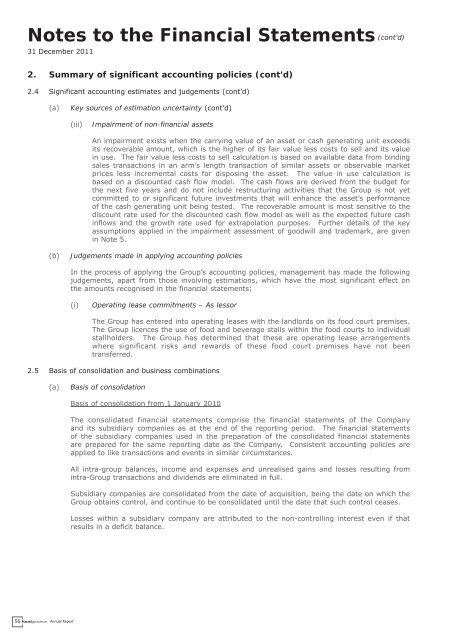Annual Report 2011 - Food Junction
Annual Report 2011 - Food Junction
Annual Report 2011 - Food Junction
You also want an ePaper? Increase the reach of your titles
YUMPU automatically turns print PDFs into web optimized ePapers that Google loves.
56<br />
Notes to the Financial Statements (cont’d)<br />
31 December <strong>2011</strong><br />
2. Summary of significant accounting policies (cont’d)<br />
2.4 Significant accounting estimates and judgements (cont’d)<br />
(a) Key sources of estimation uncertainty (cont’d)<br />
<strong>Annual</strong> <strong>Report</strong><br />
(iii) Impairment of non-financial assets<br />
An impairment exists when the carrying value of an asset or cash generating unit exceeds<br />
its recoverable amount, which is the higher of its fair value less costs to sell and its value<br />
in use. The fair value less costs to sell calculation is based on available data from binding<br />
sales transactions in an arm’s length transaction of similar assets or observable market<br />
prices less incremental costs for disposing the asset. The value in use calculation is<br />
based on a discounted cash flow model. The cash flows are derived from the budget for<br />
the next five years and do not include restructuring activities that the Group is not yet<br />
committed to or significant future investments that will enhance the asset’s performance<br />
of the cash generating unit being tested. The recoverable amount is most sensitive to the<br />
discount rate used for the discounted cash flow model as well as the expected future cash<br />
inflows and the growth rate used for extrapolation purposes. Further details of the key<br />
assumptions applied in the impairment assessment of goodwill and trademark, are given<br />
in Note 5.<br />
(b) Judgements made in applying accounting policies<br />
In the process of applying the Group’s accounting policies, management has made the following<br />
judgements, apart from those involving estimations, which have the most significant effect on<br />
the amounts recognised in the financial statements:<br />
(i) Operating lease commitments – As lessor<br />
The Group has entered into operating leases with the landlords on its food court premises.<br />
The Group licences the use of food and beverage stalls within the food courts to individual<br />
stallholders. The Group has determined that these are operating lease arrangements<br />
where significant risks and rewards of these food court premises have not been<br />
transferred.<br />
2.5 Basis of consolidation and business combinations<br />
(a) Basis of consolidation<br />
Basis of consolidation from 1 January 2010<br />
The consolidated financial statements comprise the financial statements of the Company<br />
and its subsidiary companies as at the end of the reporting period. The financial statements<br />
of the subsidiary companies used in the preparation of the consolidated financial statements<br />
are prepared for the same reporting date as the Company. Consistent accounting policies are<br />
applied to like transactions and events in similar circumstances.<br />
All intra-group balances, income and expenses and unrealised gains and losses resulting from<br />
intra-Group transactions and dividends are eliminated in full.<br />
Subsidiary companies are consolidated from the date of acquisition, being the date on which the<br />
Group obtains control, and continue to be consolidated until the date that such control ceases.<br />
Losses within a subsidiary company are attributed to the non-controlling interest even if that<br />
results in a deficit balance.


